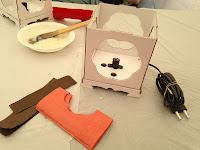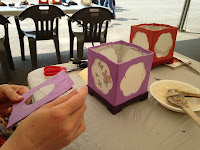I had read on several websites that the Festival this year -- on top of having changed its name from "Hanji Paper Festival" to "Hanji Culture Festival" -- had also changed its location. The festival was no longer held in the gorgeous Hanok Village, but rather next to the Hanji Industry Support Center, a very nice center (dedicated exclusively to my beloved paper) built a few years ago.
When we arrived at the Jeonju bus terminal, we hopped in a cab. I was unable to get the taxi driver to understand me (even if I was reading, syllable per syllable, the name of the place we were aiming for) so we ended up in the Hanok Village. A quick visit to my Hanji teacher's workshop and we were back on the right track! We took a nice 10-block stroll on a nice sunny Saturday morning, until we reached the Festival.
Two new locations for the 2013 Festival
 |
| The new location of the Hanji Culture Festival, in Jeonju |
Nice site, skimpy website
The volunteers who welcomed us at the entrance of the Festival were very kind, well informed and they spoke good English. They handed us the English version of the festival brochure, along with a map of the city. If the organization bothered to produce and print an English copy of their documents, why then isn't there an English version of the Festival website? A .pdf version of their English brochure available online would already be a nice start... Korea being one of the most wired and technologically inclined countries in the world, it still amazes me to see how skimpy the websites of major events can be, when they are not totally nonexistent for non-Korean speakers.
 |
| Paper snail carrying a city on its back. Cool symbol of Jeonju "slow city"! |
 |
| Hanji lanterns at the entrance of the Festival site |
The new site was very nice; gorgeous paper lanterns were hung everywhere, as well as Hanji paper banners and flags. At the entrance of the Festival were hung dozens of beautiful white Hanji lanterns, and the Hanji paper snail, symbol of Jeonju "slow city," was there to welcome us as well.
This new location, between the Hanji Industry Support Center and the Jeonju Cultural Center, is an excellent choice. The site is vast and comfortable, less crowded than the Hanok Village and completely car-free, which is great. Unfortunately, it doesn't have the traditional vibe that offers the Hanok Village (with its beautiful houses, tea shops, tiny museums, fountains and sculptures) and it pulls the Festival away from the shop owners, artisans and artists that live and do business in the Hanok Village.
Meeting the Hanji people
 |
| Coasters, Picture Frames and Small Notebooks Created by Goun Korean Paper Handicraft Goundanji |
 |
| Hanji trays Created by Koper |
Obviously, the first problem is always the language barrier; in Korea, it is constantly a problem. The presence of a "waygook-in" (외국인, Korean word that literally means "foreigner" and that is used to designated any non-Korean person) usually bring two types of opposite reactions: on one hand, Korean people will feel incredibly shy and will most likely walk away, hide or pretend they didn't see you; or, on the other hand, they will start to giggle (especially the younger ones), say "hello" way too many times and throw at you all the English sentences they have learned since Elementary school. As you can imagine, at the Hanji Festival we experienced both...
 |
| Hanji lamps Created by Doctor Hanji |
 |
| Book case with drawers Created by Ye-Dam |
Even if I wasn't able to get into real interactions with the Hanji creators, I was still very impressed with their craftsmanship. I was especially amazed with the work of the "Ye-Dam" team: their booth was filled with gorgeous pieces such as chests of drawers, book cases, tables, tea trays and lamps. Truly stunning work!
In the end, there were about half a dozen booths that were displaying Hanji creations at the Festival, which is too few, in my opinion. Is Hanji a dying art? Where are all the creators? Is having a booth at the Festival too expensive, or not beneficial enough? Or were they all in their own shop in the Hanok Village, instead of being on site at the Festival? It is surely a fair question to ask.
I have to admit that I am tempted to give it a try next year. Imagine that: a Hanji Naty booth at the Festival! A "waygook-in" with a booth at a traditional crafts Festival in Korea.... It could create a very interesting buzz, but it could also scare people away and leave me bitterly disappointed.... What do you think? Is it worth a try?
Get your hands dirty
 |
| At the Festival, we decided to make Hanji square lanterns |
The hands-on section of the Festival was very well organized. The visitors were invited to go to the ticket booth, where you could choose the object you wished to create, and pay accordingly (for example, making a square lantern cost 11,000 won). Afterwards you just go to the designated tent, and you will be guided through the process by kind and friendly Festival staff.
 |
| 11,000 won to make a square Hanji lantern |
Doing a hands-on project at a Festival like that is usually a very smooth process: all the pieces are already cut and prepared for you, and you are walked through the process step by step. For someone like me, who's been doing Hanji for a couple of years now, it can also be a little frustrating. I kept looking for my tools on the table, my awesome pair of Japanese tweezers, my spatula, my favorite brush. Also, there isn't much room for creativity and freedom: the pieces are already cut, the colors chosen, the designs expected. It's like giving a coloring book to a painter; it's still a lot of fun, but it feels constraining.
 |
| Dried flowers and leaves |
Something especially interesting for me was the use of dried flowers and leaves; it's something I had seen done (usually on Hanji fans) but that I had never experienced. The delicate leaves and petals must be handled with much care; their colors and textures are truly wonderful.
 |
| Olivia, Lee, Mandy and myself, after completion of our hands-on project |
In a following blog post, all about the Exhibit of the Hanji Craft National Contest Winners 2013!
Links to the Hanji creators websites and blogs (in Korean only) :
* Goun Korean Paper Handicraft
* Koper
* Ye-Dam Korean Paper Handicrafts (via Deokjin Self-Sufficiency Promotion Center)

No comments:
Post a Comment